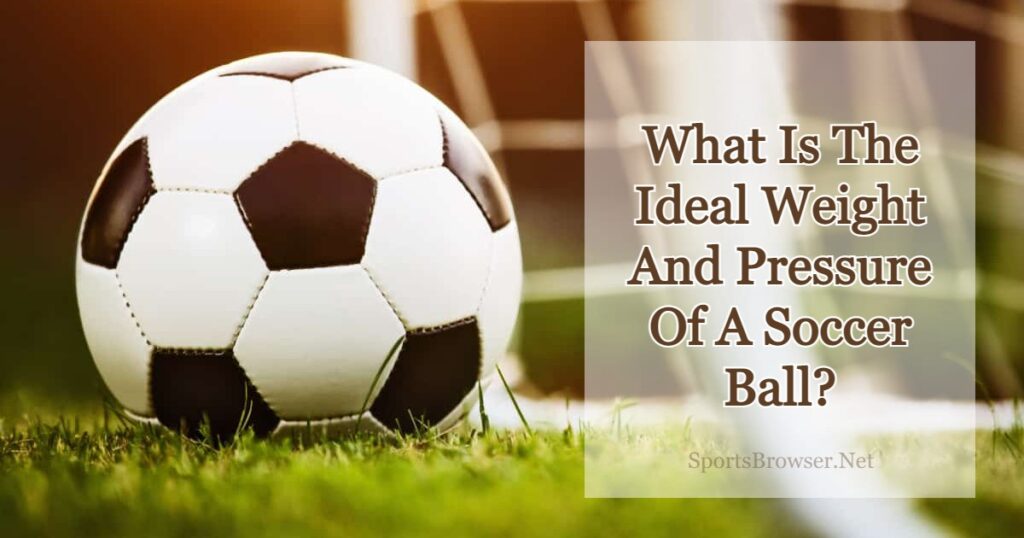Ideal Soccer Ball Weight And Pressure – A Detailed Guide
Soccer, also known as football or association football in many countries, is one of the most popular sports in the world. It is played worldwide, and the rules and regulations are determined by the governing body of each country that runs under the regulation of FIFA. But do you know what should be the ideal soccer ball weight and pressure?
One of the main elements of soccer is the ball. And its weight and pressure are two important factors that affect the overall gameplay.
We will now take a closer look at different ball weights and pressure. And we will also look at how it varies in popular soccer leagues around the world.

Soccer Ball Weight According To FIFA
The weight of a soccer ball is regulated by the laws of the game set by the FIFA (International Federation of Association Football). According to FIFA, the weight of a ball should be between 410g and 450g (14 to 16 ounces) when it is inflated to the proper pressure.
This weight is considered ideal for the game of soccer, as it allows for a good balance between control and speed.
Don’t Miss: How Big Is A Soccer Field? Detailed Dimension
Why Is The Weight Of A Soccer Ball Important?
The weight of a ball is important because it affects the overall performance and playability. A lighter ball is easier to control, but it may not have enough speed for long passes or long shots.
On the other hand, a heavier ball may have more speed, but it may be more difficult to control. The ideal weight of a soccer ball is a balance between control and speed, allowing for optimal gameplay.
Ideal Soccer Ball Pressure
The pressure of the ball is also an important factor that affects the performance and playability of the ball. According to FIFA, the pressure of a soccer ball should be between 0.6 and 1.1 atmospheres (8.5 to 15.6 pounds per square inch) when it is inflated.
Why Is The Pressure Of A Soccer Ball Important?
The pressure of a soccer ball is important because it affects performance and shot-friendliness. An under-inflated ball (with low pressure) remains too soft, making it more difficult to control, thus reducing its speed.
In contrast, an over-inflated ball (with high pressure) is too stiff, making it more difficult to control and reducing its ability to absorb the impacts of the player’s feet. The ideal pressure of a soccer ball is a balance between pace, stiffness, and control.

Ideal Ball Weight And Pressure In Different Soccer Leagues
The weight of the ball used can vary depending on the league, and so does the pressure of the ball. So let’s take a look at some of the most popular soccer leagues and the weight of the ball used in each:
- English Premier League: The ball used in the English Premier League weighs between 410g and 450g and has a pressure between 0.6 and 1.1 atmospheres.
- La Liga: The ball used in La Liga, the top tier of the Spanish league, is also between 415g and 450g and has a pressure between 0.6 and 1.1 atmospheres.
- Serie A: In Italy’s Serie A, the weight is between 420g and 450g, and the pressure is between 0.7 and 1.05 atmosphere.
- Bundesliga: The ball used in the Bundesliga, one of the most popular soccer leagues, is between 420g and 440g. In comparison, the pressure should be between 0.6 and 1 atmosphere.
- Major League Soccer (MLS): In MLS, the ball has a weight between 410g and 450g and has a pressure between 0.7 and 1 atmosphere.
- FIFA World Cup: The ball used in the FIFA World Cup, the most popular sports tournament, is also between 410g and 440g and has a pressure between 0.7 and 1.1 atmospheres.
Conclusion
The weight of a soccer ball is an important factor that affects the overall gameplay and performance of great soccer players. FIFA regulates the weight of a soccer ball, and this regulation is followed by most of the top soccer leagues in the world.
However, it is important to note that the weight and pressure of the soccer ball used can vary depending on the league, and it is essential to follow the regulations set by the governing body of each league.

